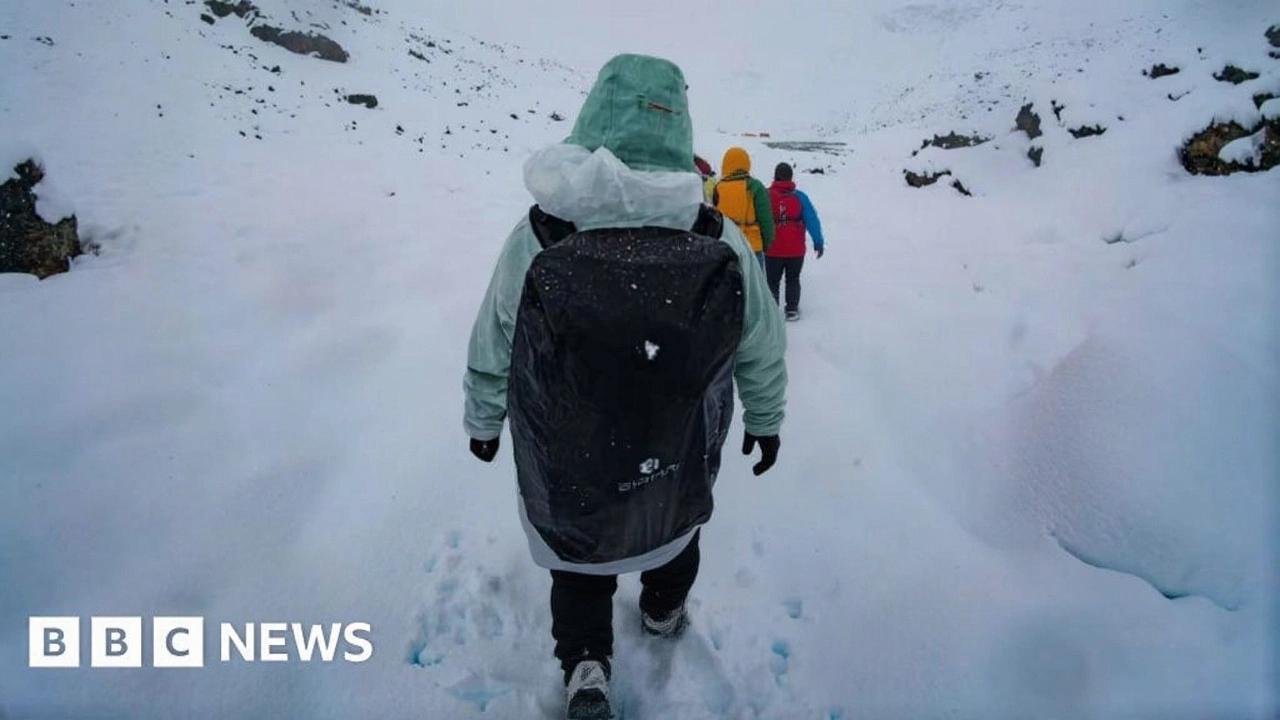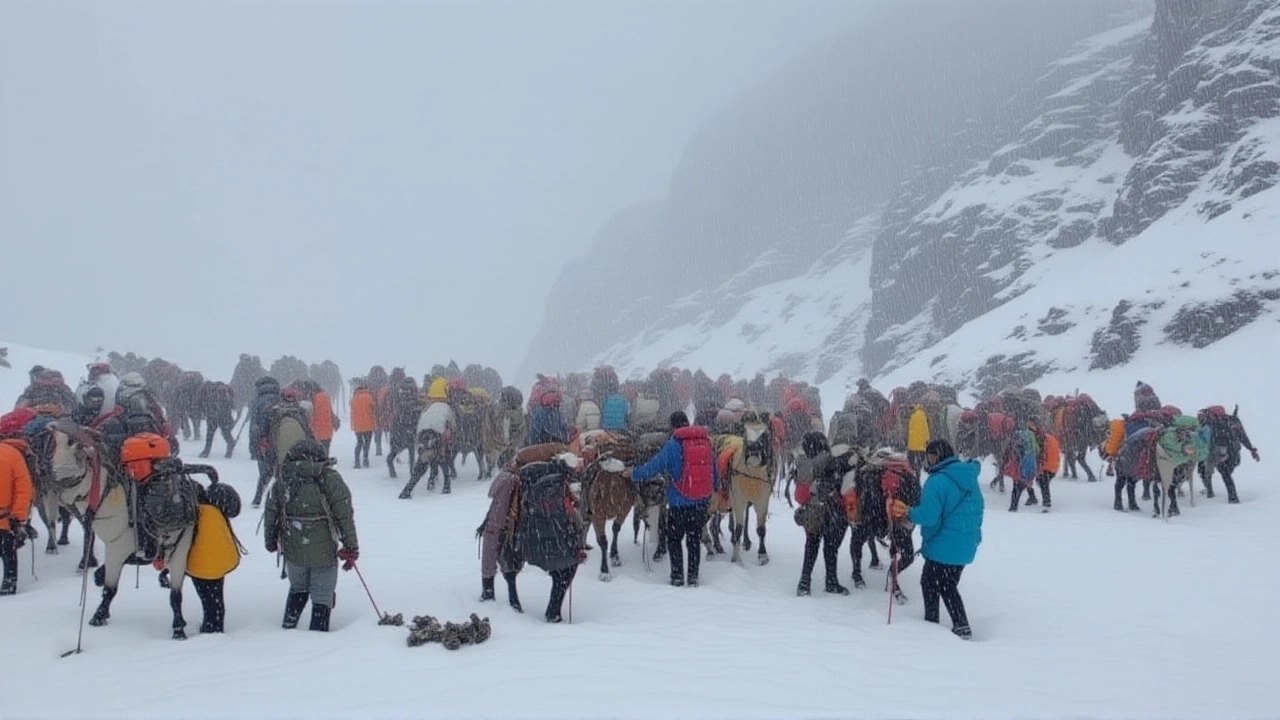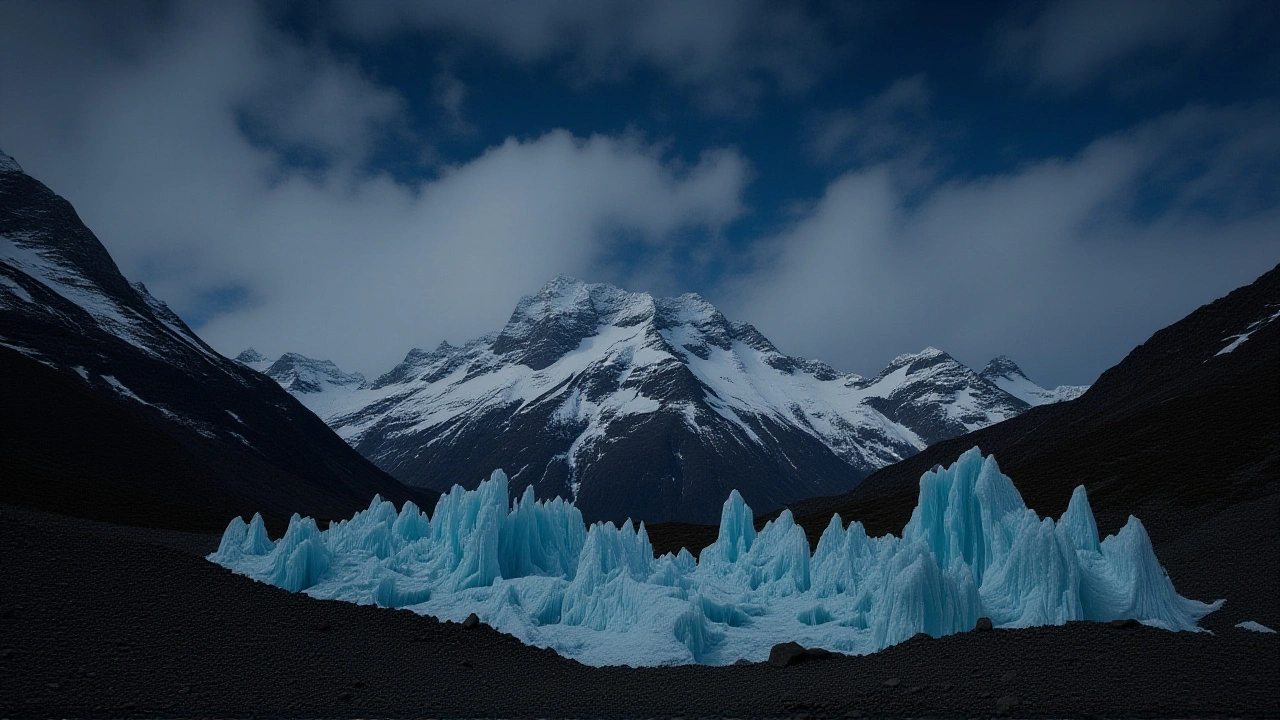When Chen Geshuang, a Chinese trekker, found himself buried in a sudden whiteout on the slopes of Mount Everest in early October 2025, the sheer scale of the crisis became clear.
The Everest blizzard erupted on Friday, October 3, 2025, catching nearly 1,000 holiday hikers off‑guard during China’s Golden Week China. By the weekend, white drifts over a meter high had turned the popular Karma Valley route into a near‑impassable maze.
Authorities from the China Tourism Administration swiftly suspended ticket sales to the Everest Scenic Area and mobilised a massive rescue effort that would involve villagers, seasoned guides, and the Tibet Autonomous Region Rescue Team.
What Went Wrong: The Unexpected October Blizzard
Normally, early October brings clear skies and thin snowpack on the Tibetan plateau, but a lingering low‑pressure system over the Bay of Bengal injected warm, moist air up the mountain chain. When that air slammed into frigid Himalayan currents at roughly 4,000 m, it created a convective snowstorm unlike any seen in October.
Snow began falling just after noon on October 3 and intensified through the night. By Saturday morning, visibility dropped to near zero, and tents that had been pitched just hours earlier were buried under foot‑deep drifts. Hikers reported having to shovel snow every ten to ninety minutes just to keep their sleeping bags from becoming runway‑like tombs.
Chen recalled, “It was wet and cold, and hypothermia felt like a real threat. The guide said he had never seen October weather like this.” His words echo a growing chorus of guides who say the event was "abnormal" even by Himalayan standards.
The Rescue Effort: Heroes on the Slopes
Within hours of the storm’s escalation, local officials ordered the deployment of the Tibet Autonomous Region Rescue Team. Hundreds of villagers—many on yak‑back—set out to clear paths and ferry stranded trekkers to safety.
The first staging point was Qudang village, perched at 4,200 m. By Wednesday, more than 350 hikers had trekked down the icy corridors to the village’s makeshift shelter, where they were handed warm tea and blankets.
Satellite phones and WeChat groups kept contact alive with roughly 200 remaining groups trapped above 4,900 m. Rescue crews, armed with rope, crampons, and portable heaters, broke through snow to reach the highest camps. As of the latest update, no fatalities have been confirmed, a testament to the speed and coordination of the response.

Tourism and Climate: Growing Tensions
Everest’s tourism boom over the past decade has turned the once‑remote region into a lucrative holiday hotspot, especially during Golden Week. Ticket sales to the Scenic Area jumped by 42 % in 2024, according to the China Tourism Administration.
But climate scientists warn that the Himalayas are warming twice as fast as the global average. A 2023 study by the University of Cambridge found that the seasonality of monsoon‑driven snowfall is shifting, making October storms increasingly likely.
Local businesses, many of which rely on the influx of Chinese tourists, now face a dilemma: should they limit numbers to preserve safety, or risk another disaster for the sake of revenue? The recent suspension of ticket sales may be a first step toward a more sustainable model.
Expert Opinions on Himalayan Weather Shifts
Dr. Lhamo Tsering, a climatologist at the Tibetan Meteorological Institute, explained, “The interaction between Bay of Bengal moisture and high‑altitude cold air is intensifying. We’re seeing more convective events that package large snow volumes in short periods.”
Meanwhile, veteran guide Pasang Dorje, who has led expeditions since the 1990s, said, “We used to plan for clear skies in October. Now we have to carry extra bivouac gear and train for rapid weather swings.”
These insights point to a broader pattern: as global warming nudges the jet stream, the Himalayas may experience more erratic, high‑impact storms, demanding a rethink of traditional trekking calendars.

Looking Ahead: Safety Measures for Future Trekkers
In response to the crisis, the China Tourism Administration announced a set of new guidelines: mandatory weather‑briefings before departure, reinforced shelter standards at high‑altitude camps, and a requirement that all tour operators equip groups with satellite communication devices.
Local authorities are also piloting an early‑warning system that fuses satellite data with ground‑based sensors to alert hikers of sudden temperature gradients.
For trekkers like Chen, the lesson is stark. “If you’re heading up Everest now, you need to expect the unexpected,” he said, still shaking off the chill. The hope is that lessons learned this October will keep future adventurers from facing the same white‑out nightmare.
Frequently Asked Questions
How many hikers are still stranded after the Everest blizzard?
Rescue officials estimate around 200 trekkers remain at higher elevations, but satellite phones confirm they are alive and in contact with teams.
What caused the October snowstorm on Mount Everest?
A low‑pressure system over the Bay of Bengal pushed warm, moist air up the Himalayas, where it collided with cold mountain air, creating a rare convective snowstorm.
Will China change its Golden Week trekking policies?
The China Tourism Administration announced stricter briefing requirements, mandatory satellite communication devices, and a temporary halt on new ticket sales for the Everest Scenic Area.
How is climate change affecting Himalayan weather?
Studies show the Himalayas are warming twice the global average, leading to more erratic monsoon patterns and an increased likelihood of sudden, high‑intensity snowstorms like the one in October 2025.
What safety measures are being introduced for future Everest treks?
New rules require advanced weather briefings, reinforced high‑altitude shelters, mandatory satellite phones, and an early‑warning system that combines satellite and ground sensors.


Lerato Mamaila
October 7, 2025 AT 05:00Wow, what an incredible rescue effort – truly a testament to human solidarity!
Jensen Santillan
October 10, 2025 AT 02:26The whole episode reads like a case study in mismanaged tourism, yet the rapid mobilization of local resources was undeniably impressive. One could argue that the authorities finally listened to the warnings of seasoned guides, but the underlying profit‑driven model remains untouched. The blizzard itself is a stark reminder that climate volatility respects no schedule, especially in high‑altitude ecosystems. It's almost poetic that the same peaks that lure adventurers also guard them with ruthless weather. Still, the narrative of heroic villagers should not eclipse the systemic issues at play.
Mike Laidman
October 12, 2025 AT 23:53The rescue appears well coordinated but the article omits certain logistical details.
Dawn Waller
October 15, 2025 AT 21:20So we got trapped in a whiteout on the "roof of the world" and what? We should have brought more yak‑milk, duh! The mountains are like, totally moodier than my ex, and you can't just blame the weather when you opted for a vacation during peak holiday season. Everest, you’re really testing our patience, like, why even bother? Maybe next time we’ll just chill in a hotel room and watch a documentary instead.
Grace Melville
October 18, 2025 AT 18:46Great job to all rescuers 😊 Stay safe out there!
Ashlynn Barbery
October 21, 2025 AT 16:13Dear colleagues, the coordinated response displayed an admirable synthesis of local expertise and modern logistics. It serves as a compelling model for future high‑altitude emergency protocols. Let us commend the villagers, guides, and rescue teams for their unwavering dedication. Their actions underscore the importance of community resilience in the face of climatic adversity. I trust that policymakers will integrate these lessons into sustainable tourism frameworks.
Sarah Graham
October 24, 2025 AT 13:40I think it’s wonderful how everyone pulled together without any drama. It shows the best of what hikers can expect from the community.
Jauregui Genoveva
October 27, 2025 AT 11:06Honestly, the whole thing is a moral lesson: nature doesn’t care about our calendars, so maybe we should stop treating it like a theme park 🎢🌨️. If you think profit trumps safety, think again. 🌍💔
Quinten Squires
October 30, 2025 AT 08:33The blizzard on Everest was a direct consequence of the altered jet stream caused by unprecedented warming in the Himalayan region. This phenomenon has been documented in multiple peer‑reviewed studies linking higher temperatures to increased moisture transport from the Bay of Bengal. When that warm air meets the sub‑zero environment at 4,000 meters, convection intensifies dramatically. The result is a rapid accumulation of snow that can overwhelm even well‑prepared expeditions. Moreover, the timing during Golden Week amplified the risk due to the sheer number of participants. The rescue teams demonstrated exemplary coordination, yet the sheer scale of the operation highlighted systemic gaps in preparedness. For instance, many groups lacked sufficient satellite communication devices despite recent mandates. The emergency shelters, though improvised, were insufficient for prolonged exposure, leading to increased cases of hypothermia. Climate models predict that such convective events will become more frequent as the Himalayas warm at twice the global average. Consequently, trekking agencies must revise their seasonal calendars and incorporate flexible evacuation protocols. The Chinese authorities’ decision to suspend ticket sales is a prudent immediate measure, but long‑term policy must address capacity limits. Over tourism not only strains local infrastructure but also raises the probability of similar disasters. A comprehensive risk assessment framework should be mandated for all high‑altitude operators. Additionally, real‑time monitoring systems integrating satellite data and ground sensors could provide earlier warnings. Investment in these technologies will likely reduce future rescue costs and, more importantly, save lives. Finally, trekkers themselves bear responsibility to respect the mountain’s evolving hazards and equip themselves accordingly.
Tyler Manning
November 2, 2025 AT 06:00While the sarcasm in the previous remark attempts to trivialize a serious event, it is imperative to recognize the profound national pride associated with Everest's heritage. The heroic deeds of the local rescue personnel warrant commendation rather than mockery. Any suggestion that the mountain's temperament merely mirrors personal moods is a disservice to both the environment and the citizens who bravely safeguard it.
james patel
November 5, 2025 AT 03:26Regarding the concise acknowledgment of the rescue operations, it is essential to contextualize the logistical frameworks employed, which leveraged both altitude‑acclimatization protocols and poly‑technical communication suites to ensure operational efficacy.
Scarlett Mirage
November 8, 2025 AT 00:53Indeed, the extensive analysis presented earlier underscores an intricate web of climatological variables; however, one must not overlook the ethical dimension-who bears responsibility when commercial interests clash with ecological stewardship? The answer, of course, lies in collective accountability; only through vigilant oversight can we hope to mitigate future catastrophes!!!
Ian Sepp
November 10, 2025 AT 22:20In response to the preceding commentary, I would like to emphasize the necessity of maintaining a professional tone while addressing such multifaceted issues. The discourse should remain anchored in factual evidence and refrain from hyperbolic exclamation.
Lois Parker
November 13, 2025 AT 19:46Looks like the mountain gave everyone a big cold shoulder.
Dennis Lohmann
November 16, 2025 AT 17:13Happy to see everyone safe! 🙌
J T
November 19, 2025 AT 14:40Yo, next time check the weather app before you think you can party on a glacier.
A Lina
November 22, 2025 AT 12:06The operational deficiencies highlighted herein reflect a systemic neglect of risk mitigation protocols, a conclusion supported by quantitative incident analyses and peer‑reviewed risk assessment literature. Moreover, the language employed in public briefings appears to understate the severity of hazard exposure, thereby compromising informed consent among participants.